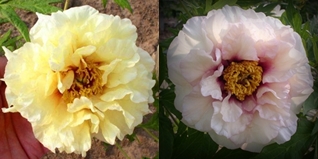Peony Glossary
Hybridizing Terms
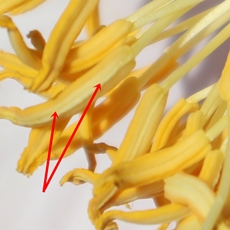
anther
A flower structure best described as an enlongated vessel which holds pollen. Found at the top of the filaments, they are often yellow in coloration are lance shaped. Some flowers do not have these structure – most often double form flowers.

asexual
Meaning reproduction without sex. This often refers to vegetative propagation. Division, tissue culture and grafting all produce identical plants through asexual reproduction. No pollen (male) or ovules (female) were involved to produce new plants.
Image: Herbaceous peony division

breeding lines
- Inbreeding: The practice of using related parents to produce offspring. This can be “selfing” see “cross”; or may use siblings or variety of closely related parents. In breeding may cause detrimental traits to accumulate in offspring, but can also serve to concentrate desired traits. Plants are less likely to show adverse impacts through inbreeding than animals.
- Line breeding: Often viewed as a form of inbreeding. This practice uses related plants to produce offspring, but may bring in outside genetics. Basically a breeding line is developed to accentuate desired traits.
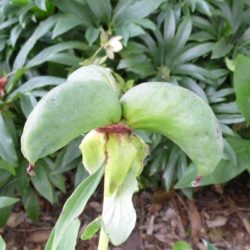
carpel(s)
The principal part of this organ is the ovary of the peony flower, a capsule protecting the ova, (eggs) leading to a pod bulging with seeds when ova are successfully fertilized. In peony flowers, carpels normally occur in clusters, but remain separate, not united (each is pollinated separately). Peonies may have 1 to 4 or more carpels.
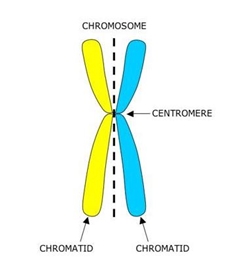
chromosome
The basic thread-like structure which are comprised of genes. See “ploidy’ for more information about chromosome configurations.

clone (clonal)
Genetically identical individuals.

cross - self (selfing)
Commonly known as self-pollination. A self cross is made through pollen from a cultivar being applied to the stigma found on the same cultivar. Thus a single cultivar serves as both male and female parent. This practice is the ultimate form of inbreeding, but may yeild interesting results through reshuffling of genes. Risks in this type of cross are concentration of defective or unbecoming traits, which the offspring may express. Positives are concentration of wanted traits and genes, and further expression of those.

cross - out (out cross)
An out cross simply uses two different parent cultivars, which are not closely related. Pollen collected from one cultivar is placed on the stigma of a completely different cultivar. A pure out cross would be the involvement of two completely unrelated cultivars, which may be difficult in the peony world as few plants in any group are completely unrelated. Out crosses typically create offspring with greater genetic and trait variability and are generally used to bring new traits into breeding lines.

cross - back (back cross)
A back cross uses offspring crossed back to its parent or grandparents. This type of cross is used to “fix” traits and create greater expression of a trait. It is a form of inbreeding.

cross - sib or sibling (sib cross)
A sib cross is one in which siblings are crossed with each other. Like the back cross, sib crosses are used to “fix” traits or create greater expression of a trait. Again another form of inbreeding.
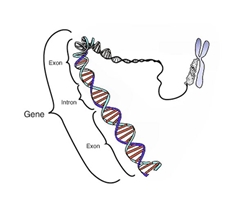
gene
Unit found within chromosomes which are transferred from a parent to offspring. Genes are the basic unit in heredity and are expressed as traits or may be held in a recessive state (no expression), dominant (always expressed), our may combine in numerous way to create an expression. Basically, genes are the codes which determine traits (characteristics). Simple Mendelian inheritance may be of assistance, but peonies often express many more complex genetic relationships.

genetic compatibility
Discussions of compatibility basically involves whether pollen (male cell of parent) can fertilize an ovule (female cell of a parent) to produce viable seed.
Genes, chromosomes, other structures and processes during cell formation in sexual reproduction (fertilization) may or may not be compatible. Differences in ploidy, or numbers of chromosomes, is often attributed to compatibility. However, parents having the same ploidy may or may not have compatibility due to any of a number of other differences. Peonies are highly complex in their reproductive processess, which can be quite fluid in different years, thus parental compatibility can be influenced.
Of importance may be chromosome size and gene loci (location). Parents with variable chromosomes, but having the same number of chromosomes may be unable to make needed pairings, thus are incompatible.

hybridizing - hybrid
Hybridizing is process which encompasses numerous disciplines in which different individuals of two different species or varieties are crossbred. Hybridizing is usually practiced for accurate purposes through hand pollination, but hybrids may be produced through open pollination. Typically, hybridizers systematically create purposeful crosses and are not reliant on open pollinated outcomes.
Some definitions of “hybrid” recognize that two different species are to be involved in a cross to make a hybrid; while others subscribe to the idea that hybrids may come from the same species with parents having different traits.

incomplete seed
Numerous peony cultivars produce incomplete seed, which may appear to be viable. These seeds often are missing the endosperm, embryo or have defects which prevent successful germination. Seeds may appear to have dents and creases, and quickly shrivel when dried a day or two. These seeds are not viable. Some cultivars produce oversized ova which encase themselves in a seed coat and are confused for viable seed.
Lutea hybrids, intersectional hybrids (Itoh group) and herbaceous hybrids are the most likely to produce incomplete seed, but species will also exhibit this behavior.
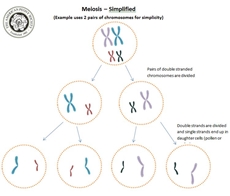
meiosis
A type of cell division found in sexually reproducing organisms. The process of meiosis begins with a normal diploid (or other chromosome configuration) cell and through division, daughter cells of haploid configuration are produced. A haploid cell, known as a gamete (sex cell), contains half the complement of chromosomes of a diploid cell. In peonies these cells are commonly called “pollen” and “ovule”. This is important for the fact that each haploid cell can combine with one of the opposite sex to create a completely new combination due to shuffling of chromosomes during mieosis. Production of a germ cell (beginning of a seed) through meiosis returns the ploidy to what was started with in its most basic form. Meiosis Chart (simplified).

mutation
The changing of the structure of a gene, resulting in variation of expression in traits. Mutation can occur naturally or through man made actions. Mutation may impact traits in many ways, some are detrimental, others may enhance a plant’s appearance, growth, etc… Mutations are most noticeable in flower color and form, but other traits are commonly altered, going unnoticed by the casual observer. Certain groups of peonies such as lutea and intersectional hybrids have noticeably more mutations, which is likely due to their divergent genetic backgrounds which are not completely compatible. At right is the lutea hybrid cultivar ‘Copper King’, showing a mutation to the right.
A fairly high percentage of mutation or unpleasing gene expression is being seen in intersectional hybrids. These hybrids have lutea hybrids as parents (in most instances) which may be responsible for the greater incidence. Unfortunately, many of these mutated plants/flowers have less appealing traits.
Hybridizing with use of a plant showing mutations may be of interest to make use of a unique trait. However, it is not known whether these traits are actually transferred to the offspring. Example: The lutea hybrid ‘Black Forest’ produced the dark red mutation ‘Foreset Shadows’. ‘Black Forest’ is a cream flower with red highlights and dark flares.. All resulting offspring of ‘Forest Shadows’ have thus far shown no propensity for the dark coloration found in this mutation and appear to be the result of original plant.
Peonies with mutations are highly prone to further mutation themselves. Often these plants revert to their original forms or to something new and less desirable. Some mutations are more stable than others and may be cultivated as separate and unique plants, but hybridizing results using them as parents remains unknown.

ploidy (diploid, tetraploid, triploid & haploid)
Ploidy refers to the number of sets of chromosomes in cells. In theory, not always in practice, plants with the same ploidy are most likely to be fertile with each other.
Common ploides:
- Diploid: Individuals who’s cells contain two complete sets of chromosomes, one originating from each parent. Diploid is considered the basic configuration of chromosomes in most organisms.
- Triploid: Individuals who’s cells contain three sets of chromosomes, two originating from one parent and one from the other. Triploids, due to their uneven ploidy are often sterile (mule), as they are the result of parents with different numbers of chromosomes. This ploidy is common in F1 generation hybrids.
- Tetraploid: Individuals who’s cells contain double sets of chromosomes (twice what diploids do). Many hybrids are tetraploids.
- Haploid: Found in the form of a gamete or sex cell (pollen or ovule) is produced through the process of meiosis. A haploid cell contains half the complement of chromosomes found in normal ploidies. This configuration allows them to be combined (pollen gamete x ovule gamete) to create a zygote (first cell of a new organism and to produce aseed in peonies).
The impact of ploidy in hybridizing peonies is variable. Parents with different ploides may sometimes produce seed and produce fertile offspring. Fertility between plants with differing ploides may be due to production of pollen (or ovules) with different ploides, among other genetic abnormalities.

pollination (hand, open)
POLLENATION – HAND
The practice of collecting pollen and physically placing the chosen pollen on the stigmas of another or same plant. This practice insures known parents are used in a cross. A selective hybridizing practice, this crossing allows the hybridizer to determine traits which may be expressed in the offspring. While hand pollination does not promise any particular outcome, it does narrow possibilities. Numerous advances have been made through hand pollinations.
POLLINATION – OPEN
Flowers (stigmas) receive pollen by an unknown vector. Most commonly, bees, flies and ants carry pollen from one flower to another or move pollen within the same flower to the stigmas. In this scenario, only one parent is known (female parent). No parent selection is made when seeds are grown from this type of cross as parents are unknown. However, it could be said that selection was made by the act of growing resulting seed. This practice deals with unknowns, but many fine plants are produced from open pollination. Some would not consider this to be a hybridizing practice, but it does contain components thereof.
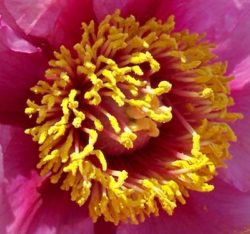
pollen
The male reproductive cells of plants. Pollen in peonies is yellow. Not all peonies produce pollen or viable pollen, thus not all may be used as male parents (commonly a problem with hybrids).
Pollen is ephemeral and must be protected from heat and sun. Pollen may be collected and dried for longer storage, but will only last a few days without refrigeration or freezing. Fresh pollen is most effective in making crosses.
Pollen which is light yellow may lack fertility. Some cultivars produce pollen sporadically over the years and close observation is required to determine pollen availability. Other cultivars (especially Japanese forms) may appear to have no pollen, however, with some additional effort anthers may be split to acquire small amounts useful in hybridizing.
A number of cultivars may produce pollen which has is not complete and lacks fertility, or may have viable pollen interspersed with non-viable pollen grains. The lutea hybrid, ‘Rosalind Elsie Franklin’ is an example of plant which produces approximately 20% viable pollen, which is highly fertile and successful crosses are numerous.
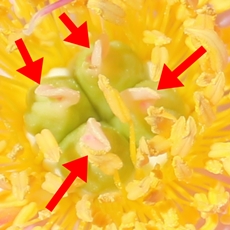
stigma
Stigmas are ribbon-like structures which serve to recieve pollen and rest atop each carpel.

